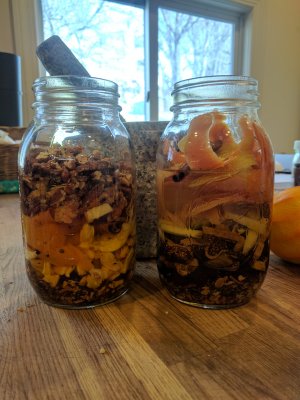Following through on an earlier threat, today I started to make two out of the four amaro recipes from Brad Thomas Parsons' Amaro.
Disclaimer
Now here's the slightly awkward part. I believe in sharing information, but these recipes are not mine to share, so I don't feel comfortable writing about them in very much detail. If you want the full recipes, you should buy the book.
I wanted to try these recipes because I realized I was in a bit of a flavor rut. Using someone else recipe allows me to explore some ingredients that I otherwise might not have tried, not from lack of interest, but from lack of initiative. The ingredients that are new to me include devil's club root, birch bark, wild cherry bark, schizandra berries, angelica root, licorice root, hops, and artichoke leaf. I ordered most of these from my usual source, Penn Herb, but a few ingredients came from Dandelion Botanical. While I was ordering a shit-ton of new herbs, I also decided to pick up some dandelion root, burdock root, and aloe ferox powder to play with. I expect I'll have a lot more to say about these in time, especially the aloe.

So, back to the amari that I won't tell you about. Today, I mixed up Parsons' Autumnal Amaro, and Winter Spice Amaro. The procedure is basically identical for both:
- Measure out ingredients
- Put into jar with neutral spirit
- Wait 3 weeks
- Strain
- Add sugar
- Let sit for another 2 weeks
- Drink


Alcoholic Calculations
The recipe calls for 3 cups of alcohol, resulting in appoximately 1 liter of amaro when all is said and done. Since I have access to 190 proof neutral spirits, a luxury that much of the country does not share, I decided that I needed to do some slightly more detailed math.
If the end result is to be 1 liter of 80 proof amaro (which is what I decided I want) then 400 ml of that must be pure ethanol. Grave's 190, true to its name, is 190 proof, or 95% alcohol. So, it takes approximately 421.05 ml of Grave's to provide 400 ml of ethanol. I rounded up to 425.
Further Complicating the Process
Something I have observed when steeping various things in Grave's 190 is that extremely high proof alcohol has certain limits. It is very efficient at extracting most flavors, but it does not extract color effectively. It seems that the dried herbs, spices, and other detritus need to be rehydrated a bit before the alcohol can begin breaking down pigments. The process that I have settled on is to macerate for two weeks at full proof, then dilute to 120 proof and macerate for a third week. This fits perfectly into the prescribed three week maceration for these recipes, so that is what I will do.
More to Come
There are two more recipes in Amaro that I plan to assemble and not tell you much about next weekend. Hopefully I can produce some more interesting and informative content when it comes time to taste and adjust the amari. I will also be making individual tinctures from all of my new ingredients, and writing up tasting notes for those as well.
